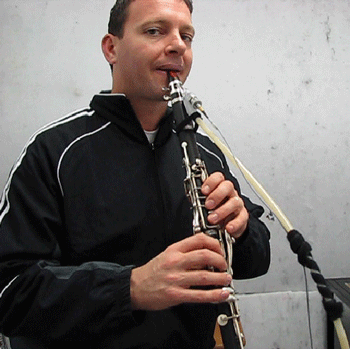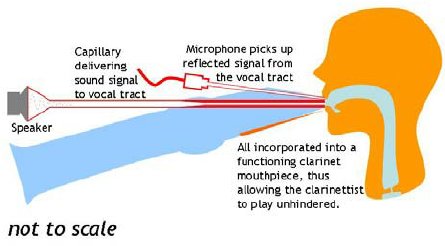Clarinet Resonance and Fingers
Seven of the tone-holes on the clarinet are covered directly by the fingers rather than key pads. Thus the player can gradually uncover the holes by progressively sliding the fingers off the clarinet. Measurements of the clarinet’s resonance at various stages of finger-slide positions clearly show the intermediate resonances created as the finger gradually slides off the holes. Over part of the instrument’s range, this contributes to the smoothly increasing playing pitch (instead of jumping in discrete ‘steps’ like a normal musical scale). But it is only part of the story.
Clarinettist’s Vocal Tract Resonance
The frequency at which the clarinet reed vibrates determines the pitch of the note played. That frequency is determined by a combination of the resonances in the bore of the instrument and the resonances in the vocal tract of the player. Usually, the clarinet’s resonances dominate and the player’s tract has only a minor effect. However, the final octave of the glissando (from C5 to C6) lies in a range of the clarinet where the clarinet resonances are weaker. In this range, experienced players can produce very strong resonances in the vocal tract comparable with or larger in magnitude than those in the clarinet: the vocal tract can ‘win’ the battle to control the reed. By tuning this resonance of the vocal tract, expert players can control the playing pitch continuously.
  |
|
A schematic of the measurements of vocal tract resonances during playing. Several eminent Sydney clarinettists came to the lab for this study. Here, Francesco Celata, of the Sydney Symphony Orchestra, plays one of the experimental instruments. |
The glissando in Rhapsody in Blue requires a strong vocal tract resonance and smooth control over a large pitch range. However, the playing pitch need only deviate from that of the fingered note by a semitone or so. Greater deviations are possible: in other experiments using a single fingering, we measured the resonances of the player’s tracts as they shifted the pitch by several notes, using the vocal tract alone.
Summary
In the clarinet, the reed’s oscillation determines the sounding note. Downstream from the reed is the clarinet bore, while the player’s vocal tract is upstream. For normal clarinet playing, downstream resonances in the clarinet bore (determined by the fingering used) dominate to drive the reed to oscillate at a particular frequency. However, if the upstream resonance in the player’s vocal tract is adjusted to be strong enough and at the appropriate frequency, the vocal tract resonance will then compete with the clarinet resonance to determine the reed’s playing frequency. (Occasionally the reed resonance has a major influence, and we hear that as a squeak!)
By skilfully coordinating the fingers to smoothly uncover the clarinet finger-holes and simultaneously tuning strong vocal tract resonances to the continuously changing pitch, expert players are able to facilitate a smooth trombone-like glissando, particularly in the final octave of the run.
Links for more information
The scientific paper reporting this study and a brief conference paper are:
- Chen, J.M., Smith J. and Wolfe, J. (2009) "Pitch bending and glissandi on the clarinet: roles of the vocal tract and partial tone hole closure" J. Acoust. Soc. America, 126, 1511-1520.
and
- Chen, J.M., Smith, J. and Wolfe, J. (2008) "How to play the first bar of Rhapsody in Blue", Acoustics 2008, Geelong, Australia. T. McGinn, editor.
Here are some references to our related work.
- Chen, J.M., Smith,. J. and Wolfe, J. (2008) "Experienced saxophonists learn to tune their vocal tracts", Science, 319, 726.
- Chen, J.M., Smith, J. and Wolfe, J. (2011) "Saxophonists tune vocal tract resonances in advanced performance techniques" J. Acoust. Soc. America. 129, 415-426.
- Tarnopolsky, A, Fletcher, N. Hollenberg, L., Lange, B., Smith, J. and Wolfe, J. (2005) "The vocal tract and the sound of a didgeridoo", Nature, 436, 39. (A short report.)
- Fritz, C. and Wolfe, J. (2005) "How do clarinet players adjust the resonances of their vocal tracts for different playing effects?", J. Acoust. Soc. America 118, 3306-3315.
- Dickens, P., Smith, J. and Wolfe, J. (2007) "High precision measurements of acoustic impedance spectra using resonance-free calibration loads and controlled error distribution", J. Acoust. Soc. America, 121, 1471-1481.
- Dickens, P., France, R., Smith,. J. and Wolfe, J. (2007) "Clarinet acoustics: introducing a compendium of impedance and sound spectra". Acoustics Australia, 35, 17-24.
Other scientific papers are at this link.
|

